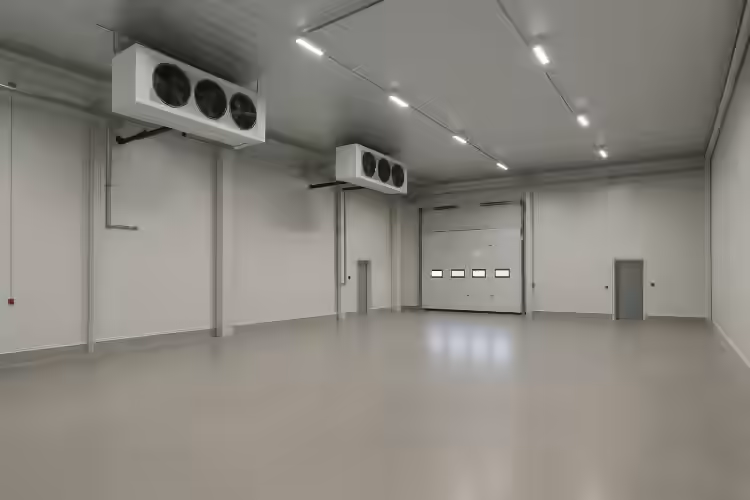Climate-Controlled Warehouses: Pros and Cons
What Is a Climate-Controlled Warehouse?
Let’s start with the basics. A climate-controlled warehouse is a facility that maintains consistent environmental conditions — usually temperature, sometimes humidity, and occasionally even air quality. This isn’t your average shed with a fan. We’retalking serious systems: HVAC, insulation, dehumidifiers, sometimes even positive air pressure and filtration. These spaces are designed to protect products from extreme cold, sweltering heat, moisture damage, and even mold or pests. It’s not about
comfort — it’s about preservation. Whether you’re operating in humid
Tampa, Florida or the dry air of
Phoenix, Arizona, these facilities are built to provide a buffer between your inventory and the outside world.
Who Needs One? (Types of Products)
So, who actually needs a climate-controlled space? It’s not just about temperature-sensitive goods. It’s about value, stability, and risk. Here are the most common candidates:- Pharmaceuticals & Medical Supplies: Many require strict FDA-compliant storage between 59°F and 77°F.
- Electronics: Sensitive to humidity and temperature swings. Condensation = damage.
- Food & Beverage: Think chocolate, wine, coffee — all can degrade in bad conditions.
- Cosmetics & Personal Care: Creams and oils don’t do well in the heat. Or the cold.
- Art, Antiques, and Collectibles: Museums aren’t the only ones who need environmental control.
- Paper Goods: Books, records, or even high-end packaging — all can warp or mold.
The Pros: Protection, Stability, and More
Here’s why climate-controlled warehouses are on the rise — especially in tighter supply chains and high-value goods handling.1. Product Integrity
Let’s state the obvious: stable environments mean fewer spoiled or damaged products. No warped electronics. No spoiled wine. No melted lipsticks in July. This isn’t just about loss prevention — it’s about keeping your brand reputation intact.2. Year-Round Consistency
From summer heatwaves to polar vortexes, weather can wreak havoc. Climate control makes your warehouse agnostic to seasons. You don’t lose sleep over next week’s forecast.3. Regulatory Compliance
Pharma? Food? Cosmetic goods? You may be legally required to store within specific temperature and humidity bands. Climate control isn’t a luxury — it’s a box you need to check.4. Employee Comfort (Side Benefit)
Some facilities double down and make climate-controlled areas more worker-friendly, too. Comfortable environments reduce turnover and injuries. It’s not the primary goal, but it’s a win.5. Fewer Infestations
Insects and rodents thrive in high humidity or uncontrolled temps. Sealed, filtered systems can dramatically reduce infestations — and the expensive treatments that follow.The Cons: Cost, Complexity, and Footprint
Sounds perfect, right? Not so fast. There’s a tradeoff — and for many, it’s a big one.1. Higher Costs (CapEx & OpEx)
This is the elephant in the warehouse. Climate-controlled facilities are more expensive — to build, to retrofit, and to run. HVACs don’t power themselves. And your energy bills? Expect a noticeable bump, especially if you're in a place likeDallas, Texas or
Miami, Florida.
2. More Maintenance
Filters need replacing. Systems need calibration. Breakdowns can be costly — especially if the goods inside can’t withstand even a short spike in temp or humidity.3. Limited Availability
Not every market has tons of climate-controlled industrial stock. And in places where demand outstrips supply, prices skyrocket.4. Reduced Usable Space
Insulation, ductwork, and clearance requirements can eat into usable storage area. You might find yourself paying for more square footage just to maintain the same inventory footprint.5. More Complexity in Operations
Split inventory across climate-controlled and ambient zones? You’ll need workflows to match. Sometimes that means more training, more scanning, more inefficiency.Real-World Use Cases
Let’s ground this in the real world for a second.- A wine distributor in Napa, California built out a 40,000 sq ft facility with dual-zone climate control. Their whites stay cool, their reds stable — and their returns? Cut in half.
- An e-commerce 3PL in Atlanta added climate-controlled racking just for beauty brands. They now cater to high-margin SKUs that require better care — and charge a premium for it.
- A biotech company in North Carolina’s RTP required strict 68°F conditions across all zones. Their space isn’t cheap — but product loss would cost more.
How to Decide If You Need Climate Control
Before you sign the dotted line or retrofit your space, here’s how to decide:1. Analyze Your SKUs
Break down what you’re storing. What’s temperature-sensitive? What has a high cost of spoilage? What has regulatory storage requirements?2. Evaluate Seasonal Risk
Are you in a climate with wide temperature swings or humidity? If yes, even non-sensitive goods might benefit from a more stable environment.3. Assess Your Supply Chain Risk Tolerance
If even a 5% spoilage rate would crush your margins, it’s probably worth the added cost.4. Do the Math
Run the numbers. Calculate added rent, utilities, and maintenance. Now compare that to reduced loss, higher throughput, or premium SKUs you could carry.5. Consider Hybrid Solutions
You don’t have to go all-in. Many operations opt for **partial climate control** — dedicating certain zones or cages to high-risk inventory. Flexible, efficient, and budget-friendly.Final Thoughts: Be Smart About Your Space
Climate-controlled warehouses aren’t for everyone — but they’re a game-changer for the right use case. It’s a tradeoff: higher cost for lower risk. The real question is, how much risk can you afford? If you’re handling temperature-sensitivegoods, storing high-value inventory, or looking to offer premium 3PL services, a controlled environment could be your edge. But don’t just jump at the buzzword. Look at your products, your processes, and your margins. Be smart about your space. Because
sometimes? A cool warehouse can make all the difference.

